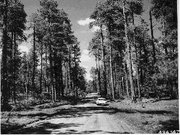Arizona-New Mexico Mountains Semidesert-Open Woodland - Coniferous Forest - Alpine Meadow Province
Contents
Arizona-New Mexico Mountains Semidesert-Open Woodland - Coniferous Forest - Alpine Meadow Province (Bailey)
Arizona, New Mexico, 50,200 mi2 (130,000 km2)
Land-surface form
This area consists mostly of steep foothills and mountains, but includes some deeply dissected high plateaus. Elevations range from 4,500 to 10,000 ft (1,370 to 3,000 m), with some mountain peaks reaching as high as 12,600 ft (3,840 m). In many areas, the relief is higher than 3,000 ft (900 m). Isolated volcanic peaks rise to considerable heights in the northwest.
Climate
Climate varies considerably with altitude. Average annual temperature is about 55F (13C) in the lower foothills and 40F (4C) on the upper mountain slopes. Average annual precipitation ranges from 10 to 35 in (260 to 890 mm), increasing with rising elevation. During late spring, there is a moisture deficit until the arrival of summer rains, which appear as thunderstorms. Rains also come in early autumn and winter. In the mountains, most precipitation is snow.
Vegetation
Vegetational zones resemble those of the Rocky Mountains, but occur at higher elevations. The foothill zone, which reaches as high as 7,000 ft (2,100 m), is characterized by mixed grasses, chaparral brush, oak-juniper woodland, and pinyon-juniper woodland. At about 7,000 ft (2,100 m), open forests of ponderosa pine are found, although pinyon and juniper occupy southfacing slopes. In Arizona, the pine forests of this zone are strongly infused with Mexican species, including Chihuahuan and Apache pine. Pine forest is replaced at about 8,000 ft (2,400 m) on northfacing slopes (a little higher elsewhere) by Douglas-fir. Aspen is common in this zone, and limber pine grows in places that are rockier and drier.
At about 9,000 ft (2,700 m), the Douglas-fir zone merges into a zone of Engelmann spruce and corkbark fir. Limber pines and bristlecone pines grow in the rockier places. An alpine belt covers relatively small areas above 11,000 ft (3,400 m).
Soils
Detailed information about orders of soils is lacking for much of this area. The Four Corners region is composed mostly of Entisols. Alfisols and Inceptisols dominate upland areas. Stony land and rock outcrops occupy large areas on the mountains and in the foothills.
Fauna
The most common large mammal is the mule deer. Mammalian predators include mountain lions, coyotes, and bobcats. Small mammals are the deer mouse, longtail weasel, porcupine, golden-mantled ground squirrel, Colorado chipmunk, red squirrel, wood rat, pocket gopher, longtail vole, Kaibab (Abert) squirrel, and cottontail.
Some of the more common birds are the northern pygmy-owl, olive warbler, red-faced warbler, hepatic tanager, mountain bluebird, pygmy nuthatch, white-breasted nuthatch, Mexican junco, Steller's jay, red-shafted flicker and the Rocky Mountain sapsucker. Goshawks and red-tailed hawks are present.
The only widely found reptile is the short-horned lizard.
Return to Ecoregions of the United States
| Disclaimer: This article is taken wholly from, or contains information that was originally published by, the United States Forest Service. Topic editors and authors for the Encyclopedia of Earth may have edited its content or added new information. The use of information from the United States Forest Service should not be construed as support for or endorsement by that organization for any new information added by EoE personnel, or for any editing of the original content. |
